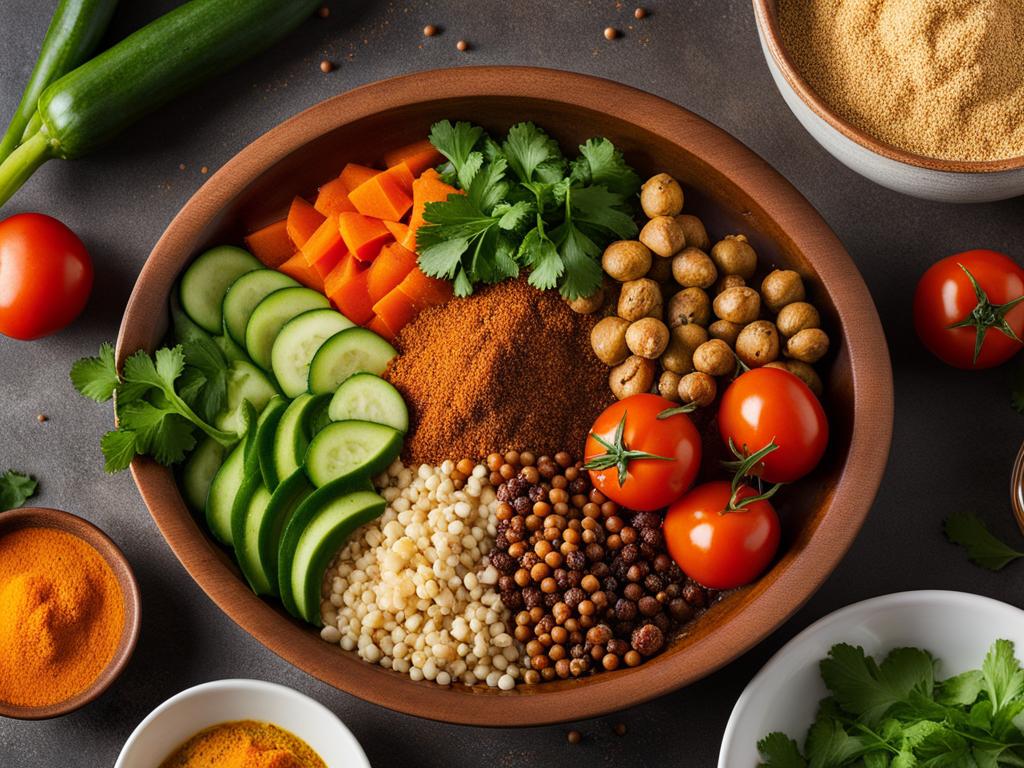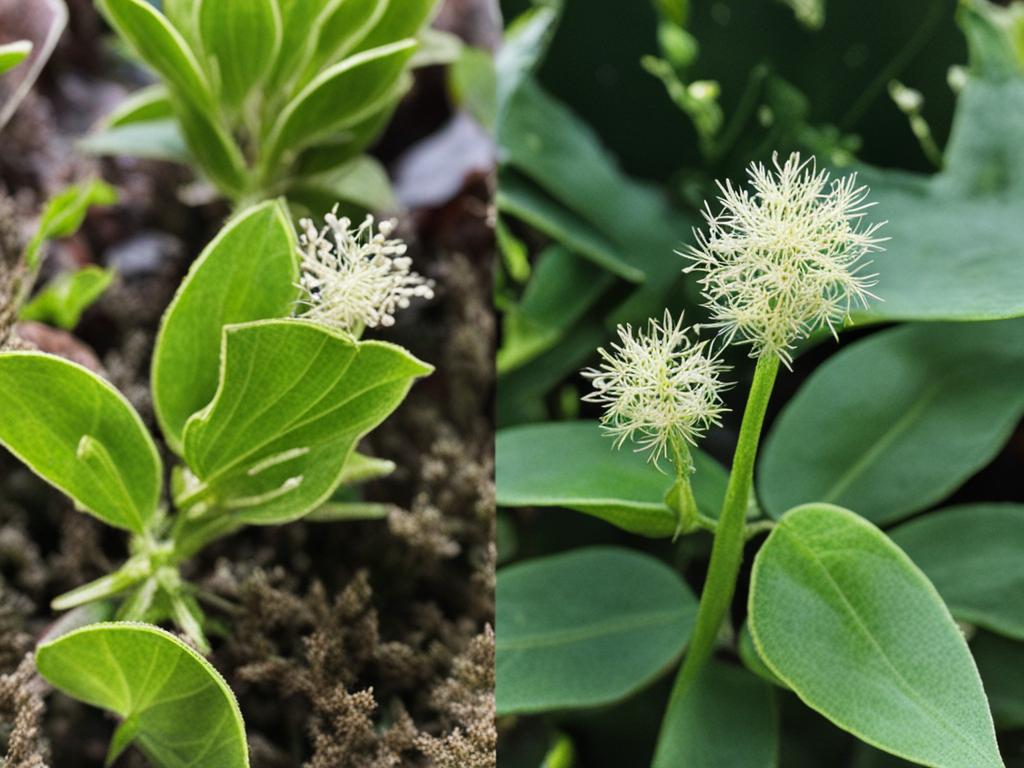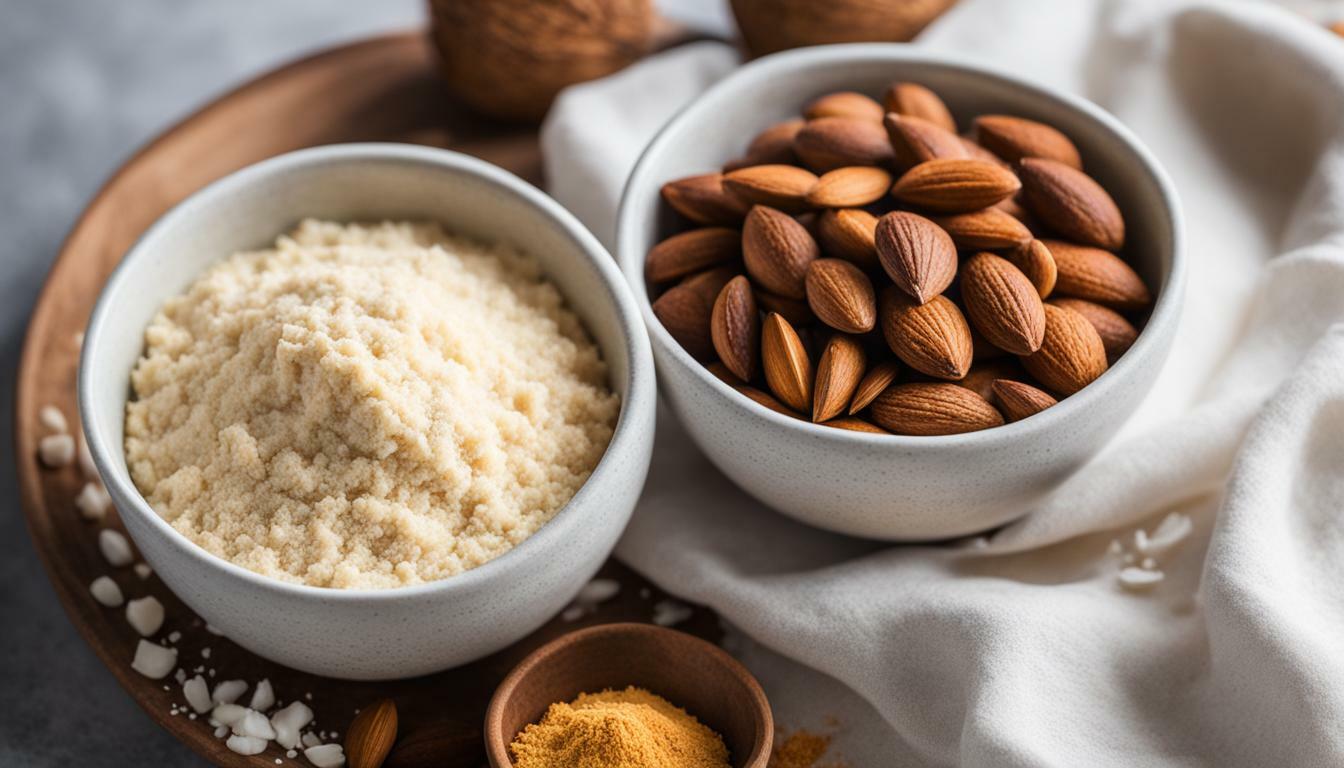Welcome to our article on the difference between coriander and cumin! These two spices are often used in cooking and can add unique flavors to dishes. Despite their similar appearances, coriander and cumin come from different plant species, resulting in distinct taste profiles. Let’s dive into the details and explore the contrasts between coriander and cumin.
Key Takeaways:
- Coriander and cumin are spices with different flavor profiles.
- Coriander has a slightly sweet, peppery lemon flavor.
- Cumin has a warm, nutty, and zesty savory pungency.
- Both spices are widely used in various cuisines around the world.
- Understanding the differences between coriander and cumin allows for enhanced cooking experiences and flavorful dishes.
Origins and Uses of Cumin
Cumin, a spice with a rich history dating back thousands of years, has its origins in the eastern Mediterranean region. It has been highly valued by ancient civilizations such as the Egyptians, Greeks, and Romans for its aromatic and medicinal properties. Today, cumin is widely used in various cuisines around the world.
In Indian cuisine, cumin is a key ingredient in spice blends like garam masala and curry powder. It is used to season curries, lentil dishes, and vegetable preparations, adding a distinctive flavor to these dishes. In Mexican cuisine, cumin is commonly used in dishes like chili con carne, tacos, and enchiladas, bringing a warm and earthy taste to the food. Middle Eastern cuisines also incorporate cumin in dishes like hummus, falafel, and kebabs, enhancing the overall flavor profile.
With its versatility and ability to enhance the taste of various dishes, cumin has become a staple spice in many kitchens. Its distinct flavor and aroma make it an indispensable ingredient in different culinary traditions, adding depth and complexity to a wide range of recipes.
Culinary Uses and Recipes with Cumin
Cumin is a versatile spice that can be used in a multitude of dishes. Its warm and earthy flavor pairs well with a variety of ingredients, making it a popular choice in both savory and sweet recipes. Here are a few culinary uses and recipes that showcase the versatility of cumin:
| Cuisine | Recipe |
|---|---|
| Indian | Chicken Tikka Masala: A popular Indian dish featuring marinated chicken cooked in a tomato-based sauce flavored with cumin and other spices. |
| Mexican | Guacamole: A classic Mexican dip made with mashed avocados, tomatoes, onions, cilantro, lime juice, and cumin for an added kick. |
| Middle Eastern | Falafel: Crispy vegetarian patties made from ground chickpeas, herbs, and spices, including cumin, served in pita bread with tahini sauce and fresh vegetables. |
These are just a few examples of the many culinary possibilities with cumin. Its versatility allows you to experiment and create unique and delicious dishes across different cuisines.
Origins and Uses of Coriander
Coriander, also known as cilantro or Chinese parsley, has a long history that spans centuries. It originated in the Mediterranean region and has been cultivated since ancient times. It is a versatile herb used in various cuisines around the world. In Indian cuisine, coriander adds a fresh and citrusy flavor to curries, chutneys, and pickles. In Mexican cuisine, it is a key ingredient in salsas, guacamole, and tacos, lending its distinctive taste. Middle Eastern cuisines, such as Moroccan and Lebanese, incorporate coriander into spice blends like ras el hanout and za’atar. Coriander is valued for its culinary uses and also has medicinal properties.
Coriander is widely used in cooking due to its unique flavor profile. Its bright, citrusy notes add a refreshing element to dishes, making it a popular choice in various cuisines. It is often used as a garnish or ingredient to enhance the taste and aroma of salads, salsas, curries, and pickles. Additionally, coriander is a vital component of spice blends like garam masala and ras el hanout, which are used to season a wide range of dishes.
In Indian cuisine, coriander is an essential herb, adding depth and complexity to curries, chutneys, and marinades. It is also commonly used in South Asian and Southeast Asian cuisines for its distinctive flavor. In Mexican cuisine, coriander is a staple ingredient in salsas, guacamole, and tacos, providing a fresh and tangy taste. Middle Eastern cuisines incorporate coriander into popular spice blends like ras el hanout and za’atar, which are used to flavor meats, rice, and vegetables.
| Cuisine | Uses |
|---|---|
| Indian | Curries, chutneys, spice blends |
| Mexican | Salsas, guacamole, tacos |
| Middle Eastern | Ras el hanout, za’atar |
Coriander is valued not only for its culinary uses but also for its medicinal properties. It is believed to aid in digestion, reduce inflammation, and promote overall well-being. With its rich history and versatility, coriander continues to be an essential ingredient in cuisines across the globe.
Coriander vs Cumin in Flavor Profile
Understanding the flavor profiles of coriander and cumin is essential for any aspiring chef or food enthusiast. These two spices have distinct tastes that can elevate the flavors of your dishes in unique ways.
Coriander, also known as cilantro, has a slightly sweet flavor with hints of peppery lemon. It adds a refreshing and citrusy note to dishes, making it a popular choice in various cuisines. On the other hand, cumin has a warm, nutty flavor with a zesty savory pungency. Its depth and complexity make it a versatile spice in many recipes.
When used together, coriander and cumin create a harmonious balance. They complement each other’s flavors and enhance the overall taste of a dish. The combination of coriander’s vibrant sweetness and cumin’s rich savoriness can transform a simple meal into a culinary delight.
Whether you’re cooking Indian curries, Mexican salsas, or Middle Eastern dishes, understanding the flavor profiles of coriander and cumin allows you to use these spices effectively and experiment with different combinations. Let your taste buds be your guide as you explore the diverse flavors these spices have to offer.
| Coriander | Cumin |
|---|---|
| Slightly sweet with hints of peppery lemon | Warm, nutty with a zesty savory pungency |
| Lighter and more vibrant flavor | Deeper and more complex flavor |
| Used in seasoning mixes like garam masala and ras el hanout | Found in spice blends like curry powder and taco seasoning |
As you explore the world of spices and flavors, keep coriander and cumin in your culinary arsenal. Their distinct flavor profiles and versatile uses will undoubtedly elevate your cooking and delight your taste buds.

Culinary Uses and Recipes for Coriander and Cumin
Coriander and cumin are both versatile spices that add unique flavors to a wide range of dishes. Let’s explore their culinary uses and some delicious recipes that showcase their distinct profiles.
Culinary Uses of Coriander
Coriander is a popular herb that is used in both fresh and dried forms. Its fresh leaves, known as cilantro, are commonly used as a garnish in salads, salsas, and soups. The dried seeds of the coriander plant are used as a spice in various cuisines around the world.
In Indian cooking, coriander is a key ingredient in spice blends like garam masala and curry powder. It adds a fresh and citrusy flavor to curries, chutneys, and pickles. In Mexican cuisine, coriander is often used in salsas, guacamole, and tacos, adding a distinctive taste. Middle Eastern cuisines, such as Moroccan and Lebanese, incorporate coriander into spice blends like ras el hanout and za’atar.
With its versatile flavor profile, coriander can be used in a wide variety of dishes, from savory to sweet. It pairs well with ingredients like citrus, garlic, and cumin, enhancing the overall taste of the dish.
Culinary Uses of Cumin
Cumin is a spice with a warm, nutty flavor and a zesty savory pungency. It is widely used in cuisines such as Indian, Mexican, and Middle Eastern.
In Indian cuisine, cumin is a staple spice in dishes like curries, lentil dishes, and vegetable preparations. It is also an essential ingredient in spice blends like garam masala and curry powder. In Mexican cuisine, cumin is used in dishes like chili con carne, tacos, and enchiladas, adding depth and complexity to the flavors. In Middle Eastern cuisines, cumin is used in dishes like hummus, falafel, and kebabs, contributing to the authentic taste.
Cumin pairs well with spices like coriander, turmeric, and cinnamon, and its earthy flavor adds a distinct richness to dishes.
| Recipes with Coriander | Recipes with Cumin |
|---|---|
| Turkish Stuffed Peppers | Gyro Meat |
| Beef Satay | Chili |
| Pickled Cauliflower | Cumin Carrot Soup |
These recipes demonstrate how coriander and cumin can be used to enhance the flavors of a variety of dishes. Whether you’re cooking a vegetarian curry or grilling meat for a barbecue, these spices will add depth and complexity to your recipes.
Remember to experiment with different flavor combinations and amounts to suit your taste preferences. Coriander and cumin are versatile spices that can turn a simple dish into something extraordinary.

“Coriander and cumin are versatile spices that add depth and complexity to a wide range of dishes.”
Conclusion
In summary, coriander and cumin are two distinct spices with different flavor profiles and culinary uses. Coriander has a slightly sweet, peppery lemon flavor, while cumin has a warm, nutty, and zesty savory pungency. These differences make them unique and versatile ingredients in the kitchen.
Coriander is often used in seasoning mixes like garam masala and ras el hanout, adding freshness and citrusy notes to dishes. It is also valued for its culinary uses in various cuisines, such as Indian, Mexican, and Middle Eastern.
On the other hand, cumin is known as a “warming spice” and is widely used in Indian, Mexican, and Middle Eastern cuisines. It adds depth and complexity to dishes like curries, chili, tacos, and hummus.
Understanding the distinctions between coriander and cumin allows chefs and home cooks to create unique and delicious dishes by leveraging the specific flavors and characteristics of each spice. Whether used individually or in combination, coriander and cumin bring their own unique contributions to the world of culinary exploration.
FAQ
What is the difference between coriander and cumin?
Coriander and cumin are seeds from completely different plant species, resulting in distinct flavor profiles.
What are the origins and uses of cumin?
Cumin originated in the eastern Mediterranean region and has been cultivated and valued for its aromatic and medicinal properties by ancient civilizations. It is widely used in Indian, Mexican, and Middle Eastern cuisines.
What are the origins and uses of coriander?
Coriander originated in the Mediterranean region and has been cultivated since ancient times. It is a versatile herb used in various cuisines around the world, including Indian, Mexican, and Middle Eastern cuisines.
How do the flavor profiles of coriander and cumin differ?
Coriander has a slightly sweet, peppery lemon flavor, while cumin has a warm, nutty, and zesty savory pungency.
What are the culinary uses and recipes for coriander and cumin?
Coriander is used as a garnish or ingredient in dishes like salads, curries, and pickles, while cumin is used in a wide range of dishes from different cuisines, including curries, chili, and hummus.
 Skip to main content
Skip to main content


